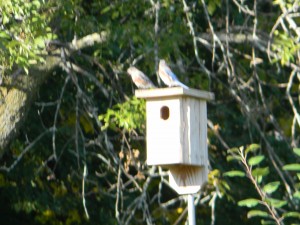How Many Humans Does It Take To Raise a Baby Bluebird?
In Warner Park, the answer is at least 25.
Take a walk through wild Warner, in the back meadow and near the dog park, and you’ll see eight neat little wooden bird houses, mounted on metal poles. In the meadow, listen carefully near birdhouse number two, just off the main path. In September you’ll still hear the mournful yodel-warble of a male bluebird whose gangly teenagers are about to go their own way, just like the freshmen college students so many parents have been wistfully pushing out of the nest for the past two weeks.
Approach that little birdhouse. Notice how the front is stained purple from the mulberries the father delivered every few minutes, back and forth, back and forth, across the meadow, all summer. Now back away and the turquoise and rust-colored patriarch may swoop down from his nearby linden perch and sit on house number two to make a point—it’s his, leave it alone–he’ll be back next year to raise another family.
 This bluebird business started one summer night exactly a year ago, when I read about proposals in a neighborhood plan that could have hurt the birds in our park. I didn’t know who to call or what to do but then I thought “birds, bird people– Audubon.”
This bluebird business started one summer night exactly a year ago, when I read about proposals in a neighborhood plan that could have hurt the birds in our park. I didn’t know who to call or what to do but then I thought “birds, bird people– Audubon.”
Enter human bluebird parent number one: northsider Paul Noeldner. I barely knew Paul, but I left an urgent message on his voicemail, after 9:00pm. He called back within the hour and we met the next morning at Manna Café. For Northsiders who know Paul, you know that to say he was wildly enthusiastic would be an understatement. With silvery hair askew like a Cedar Waxwing’s crest in the wind, he spit out a flurry of ideas. One was to create a Warner bluebird trail. I listened, nodding, thinking, yeh, yeh, right, we’ll have time to do that.
But then he didn’t go away. He started appearing on my doorstep with bird books and donuts and soft pine needles to put in birdhouses to help bluebirds when their nests get wet, and the next thing I knew, I was in charge of eight bluebird houses. Paul did everything but sit on those bluebird eggs himself, and if he could have fit in House #2, he would have done that, too.
If Paul is the mother of Warner’s bluebirds, Jack Hurst, long-time northside conservationist, is their father. Jack is the other person I call late at night when I am worried about Warner Park. For the past several decades, Jack has worked through the Dane County Conservation League (DCCL) and the Yahara Fishing Club to save land and wildlife on the Northside and in Wisconsin. He has taught hundreds of Madison’s children to fish during the Warner fishing days he organizes and he has campaigned tirelessly to improve our water quality. In Warner Park, if it flies, if it swims, if it breathes, Jack Hurst is its champion.
While Paul was working through Audubon to get four houses donated (thank you Mark Martin, Jerry Martin and Patrick Ready), Jack was getting the Dane County Conservation League to build and donate the other four houses (thank you to at least a dozen DCCL volunteers). Then parks department employees Craig Klinke and Russ Hefty helped place and install the houses, along with neighbor Jim Carrier.
In addition to this immediate human family of over 25, our bluebirds have a large extended family in the Bluebird Restoration Association of Wisconsin (BRAW). Their grandfather is Northsider Mike Rewey, who helped start Wisconsin’s bluebird recovery program. Thank you to Mike and to all BRAW members for helping to keep Warner wild.
(By Trish O’Kane, Reprinted From the Northside News October/November 2010)
You must be logged in to post a comment.